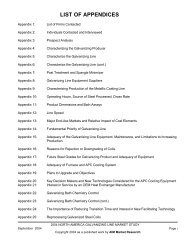EAF Dust Treatment and Disposal
EAF Dust Treatment and Disposal
EAF Dust Treatment and Disposal
- No tags were found...
You also want an ePaper? Increase the reach of your titles
YUMPU automatically turns print PDFs into web optimized ePapers that Google loves.
GENERAL <strong>EAF</strong> MELT SHOP INFORMATION<strong>EAF</strong> shops in the survey produced 54.7 million tons of steel in 1999, <strong>and</strong> operated at roughly 82% of theircapacity of 67.1 million tons. The plants surveyed represented 94% of the total <strong>EAF</strong> steel production in the U.S.<strong>and</strong> Canada <strong>and</strong> approximately 44% of the total steel production (123.8 million tons) for the U.S. <strong>and</strong> Canada in1999. Overall, the <strong>EAF</strong> shops that responded to the survey projected an 11% increase in annual steel productionin 2000.Carbon steel production accounted for 81% of the steel produced by the <strong>EAF</strong> shops surveyed, alloy steelsaccounted for 15%, stainless steel accounted for 3%, <strong>and</strong> resulfurized <strong>and</strong> silicon steels accounted for theremaining 1%.IRON BEARING CHARGE MATERIAL MELTEDThe types of scrap <strong>and</strong> other iron bearing charge materials (IBCMs) consumed in the production of steel have asignificant impact on the quantity of <strong>EAF</strong> dust generated. Higher qualities of steel scrap contain less residuals<strong>and</strong> other heavy metals, such as zinc, lead, cadmium, etc. <strong>and</strong> lower qualities of steel scrap result in greater dustvolumes <strong>and</strong> higher levels of these heavy metals in the dust. For this reason, we also obtained information aboutthe IBCMs consumed by these plants including scrap types, pig iron, <strong>and</strong> alternative iron sources such as DRI<strong>and</strong> HBI. Shredded scrap is the type of iron bearing charge material most frequently (85%) melted by the <strong>EAF</strong>plants surveyed. Shredded scrap also accounts for the largest single share (25%) of IBCM consumed by the<strong>EAF</strong> shops that responded.CURRENT <strong>EAF</strong> DUST DISPOSITIONThe two fundamental alternatives for disposing of <strong>EAF</strong> dust are l<strong>and</strong>filling <strong>and</strong> recycling. When decidingbetween these alternatives, several factors are essential. The main factors are economic (treatment <strong>and</strong>transportation costs), environmental (regulations <strong>and</strong> conservation), long term liability, <strong>and</strong> concerns overpublic opinion. Overall, 63% (47) of the 75 plants that responded arrange to have <strong>EAF</strong> dust recycled in a HighTemperature Metals Recovery (HTMR) facility, 41% (31) utilize a L<strong>and</strong>fill, <strong>and</strong> 5% employ other recyclingtechniques. Several employ more than one <strong>EAF</strong> dust disposal solution.Recycling <strong>EAF</strong> dust using an HTMR process is most common (73%) among the Minimill Long Products <strong>EAF</strong>shops <strong>and</strong> least common (50%) in the Carbon/Alloy Flat Roll plants. Employing l<strong>and</strong>fills for disposal is mostcommon (60%) in the Specialty Long Products plants, but these plants are also most likely (7%) to be usingother recycling methods. Overall, 54% (586,939 tons) of the total quantity of <strong>EAF</strong> dust generated by the plantssurveyed is recycled; 45% (470,518 tons) is l<strong>and</strong>filled. While some plants employ both options, the majority of





